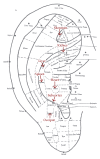The stimulation effect of auricular magnetic press pellets on older female adults with sleep disturbance undergoing polysomnographic evaluation
- PMID: 23573133
- PMCID: PMC3618916
- DOI: 10.1155/2013/530438
The stimulation effect of auricular magnetic press pellets on older female adults with sleep disturbance undergoing polysomnographic evaluation
Abstract
Study Objectives. To examine the stimulation effect of auricular magnetic press pellet therapy on older female adults with sleep disturbance as determined by polysomnography (PSG). Design. Randomized, single-blind, experimental-controlled, parallel-group. Setting. Community. Participants. Twenty-seven older female adults with sleep disturbance according to the Pittsburgh Sleep Quality Index (PSQI) >5 for at least 3 months were recruited. Participants were screened by both the Hospital Anxiety and Depression Scale (HADS) and the Mini-Mental State Examination (MMSE), as well as polysomnography prior to randomization. Interventions. All eligible participants were randomly allocated into the experimental or control group. Both groups were taped with magnetic press pellet on auricular points for 3 weeks. The experimental group was treated by applying pressure on the magnetic press pellets 3 times per day while no stimulation was applied on the control group. Measurements and Results. Both groups were measured by PSG and PSQI at the beginning of the study and 3 weeks after the study. Both groups showed improvements on PSQI scores compared to the baseline. One-way analysis of covariance adjusted for baseline scores showed that significant improvements of PSG-derived sleep parameters, such as sleep efficiency, were found in the experimental group. However, no significant differences between groups were observed in the proportion of sleep stages with the exception of Stage 2. Conclusions. Auricular therapy using magnetic pellets and stimulation by pressing was more effective in improving the sleep quality compared to auricular therapy without any stimulation.
Figures
Similar articles
-
Adaptive Auricular Point Acupressure for Sleep Disturbance in Women with Breast Cancer: A Randomized Controlled Trial.Evid Based Complement Alternat Med. 2022 Oct 31;2022:8637386. doi: 10.1155/2022/8637386. eCollection 2022. Evid Based Complement Alternat Med. 2022. PMID: 36353150 Free PMC article.
-
Effects of Auricular Acupressure on Sleep Quality, Anxiety, and Depressed Mood in RN-BSN Students With Sleep Disturbance.J Nurs Res. 2018 Feb;26(1):10-17. doi: 10.1097/JNR.0000000000000209. J Nurs Res. 2018. PMID: 29315203
-
Novel Augmentation Strategies in Major Depression.Dan Med J. 2017 Apr;64(4):B5338. Dan Med J. 2017. PMID: 28385173 Review.
-
Depressive symptoms account for differences between self-reported versus polysomnographic assessment of sleep quality in women with myofascial TMD.J Oral Rehabil. 2017 Dec;44(12):925-933. doi: 10.1111/joor.12552. Epub 2017 Sep 21. J Oral Rehabil. 2017. PMID: 28853162 Free PMC article.
-
Psychological treatment for insomnia in the regulation of long-term hypnotic drug use.Health Technol Assess. 2004 Feb;8(8):iii-iv, 1-68. doi: 10.3310/hta8080. Health Technol Assess. 2004. PMID: 14960254 Review.
Cited by
-
Effectiveness of Acupuncture and Acupressure for Improving the Sleep Quality of Menopausal Women: A Meta-Analysis.Iran J Med Sci. 2025 Mar 1;50(3):132-145. doi: 10.30476/ijms.2024.102726.3586. eCollection 2025 Mar. Iran J Med Sci. 2025. PMID: 40224208 Free PMC article.
-
Auricular acupuncture with seed or pellet attachments for primary insomnia: a systematic review and meta-analysis.BMC Complement Altern Med. 2015 Apr 2;15:103. doi: 10.1186/s12906-015-0606-7. BMC Complement Altern Med. 2015. PMID: 25886561 Free PMC article.
-
Adaptive Auricular Point Acupressure for Sleep Disturbance in Women with Breast Cancer: A Randomized Controlled Trial.Evid Based Complement Alternat Med. 2022 Oct 31;2022:8637386. doi: 10.1155/2022/8637386. eCollection 2022. Evid Based Complement Alternat Med. 2022. PMID: 36353150 Free PMC article.
-
Efficacy and safety of non-pharmacological therapies for primary insomnia: a network meta-analysis.Front Neurol. 2025 Jul 29;16:1607903. doi: 10.3389/fneur.2025.1607903. eCollection 2025. Front Neurol. 2025. PMID: 40808922 Free PMC article.
-
Comparison of Magnetic Auriculotherapy, Laser Auriculotherapy and Their Combination for Treatment of Insomnia in the Elderly: A Double-Blinded Randomised Trial.Evid Based Complement Alternat Med. 2019 May 21;2019:3651268. doi: 10.1155/2019/3651268. eCollection 2019. Evid Based Complement Alternat Med. 2019. PMID: 31239857 Free PMC article.
References
-
- Kao CC, Huang CJ, Wang MY, Tsai PS. Insomnia: prevalence and its impact on excessive daytime sleepiness and psychological well-being in the adult Taiwanese population. Quality of Life Research. 2008;17(8):1073–1080. - PubMed
-
- Chiu HF, Leung T, Lam LC, et al. Sleep problems in Chinese elderly in Hong Kong. Sleep. 1999;22(6):717–726. - PubMed
-
- Kim K, Uchiyama M, Okawa M, Liu X, Ogihara R. An epidemiological study of insomnia among the Japanese general population. Sleep. 2000;23(1):41–47. http://www.ncbi.nlm.nih.gov/pubmed/10678464. - PubMed
-
- Morphy H, Dunn KM, Lewis M, Boardman HF, Croft PR. Epidemiology of insomnia: a longitudinal study in a UK population. Sleep. 2007;30(3):274–280. http://search.ebscohost.com/login.aspx?direct=true&db=cmedm&AN=17425223&.... - PubMed
LinkOut - more resources
Full Text Sources
Other Literature Sources




